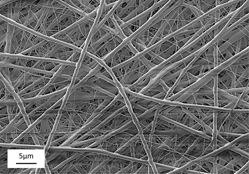Crossref Citations
This article has been cited by the following publications. This list is generated based on data provided by
Crossref.
Halperin, Victor
Shter, Gennady E.
Beilin, Vadim
and
Grader, Gideon S.
2015.
Mesoporous K/Fe–Al–O nanofibers by electrospinning of solution precursors.
Journal of Materials Research,
Vol. 30,
Issue. 20,
p.
3142.
Bauer, Matthew J.
Snyder, Catherine S.
Bowland, Christopher C.
Uhl, Amanda M.
Budi, Maeve A. K.
Villancio‐Wolter, Maria
Sodano, Henry A.
and
Andrew, Jennifer S.
2016.
Structure–Property Relationships in Aligned Electrospun Barium Titanate Nanofibers.
Journal of the American Ceramic Society,
Vol. 99,
Issue. 12,
p.
3902.
Bajaj, Bharat
Hong, Seonghwan
Jo, Seong Mu
Lee, Sungho
and
Kim, Hyun Jae
2016.
Flexible carbon nanofiber electrodes for a lead zirconate titanate nanogenerator.
RSC Advances,
Vol. 6,
Issue. 69,
p.
64441.
Rozent, Ofer
Beilin, Vadim V.
Shter, Gennady E.
Grader, Gideon S.
and
Jones, J.
2016.
Deformation Control During Thermal Treatment of Electrospun PbZr0.52Ti0.48O3 Nanofiber Mats.
Journal of the American Ceramic Society,
Vol. 99,
Issue. 5,
p.
1550.
Li, Bin
and
Zhong, Wei-Hong
2016.
Polymer Nanocomposites for Dielectrics.
p.
35.
Elishav, Oren
Beilin, Vadim
Rozent, Ofer
Shter, Gennady E.
and
Grader, Gideon S.
2018.
Thermal shrinkage of electrospun PVP nanofibers.
Journal of Polymer Science Part B: Polymer Physics,
Vol. 56,
Issue. 3,
p.
248.
Elishav, Oren
Poliak, Liz
Naamat, Iris
Beilin, Vadim
Shter, Gennady E.
and
Grader, Gideon S.
2019.
Lamellar-like Electrospun Mesoporous Ti-Al-O Nanofibers.
Materials,
Vol. 12,
Issue. 2,
p.
252.
Mann‐Lahav, Meirav
Halabi, Manar
Shter, Gennady E.
Beilin, Vadim
Balaish, Moran
Ein‐Eli, Yair
Dekel, Dario R.
and
Grader, Gideon S.
2020.
Electrospun Ionomeric Fibers with Anion Conducting Properties.
Advanced Functional Materials,
Vol. 30,
Issue. 18,
Elishav, O.
Shener, Y.
Beilin, V.
Shter, G. E.
Ng, B.
Mustain, W. E.
Landau, Miron V.
Herskowitz, Moti
and
Grader, G. S.
2020.
Electrospun nanofibers with surface oriented lamellar patterns and their potential applications.
Nanoscale,
Vol. 12,
Issue. 24,
p.
12993.
Zaarour, Bilal
Zhu, Lei
and
Jin, Xiangyu
2020.
Direct generation of electrospun branched nanofibers for energy harvesting.
Polymers for Advanced Technologies,
Vol. 31,
Issue. 11,
p.
2659.
Halabi, Manar
Mann-Lahav, Meirav
Beilin, Vadim
Shter, Gennady E.
Elishav, Oren
Grader, Gideon S.
and
Dekel, Dario R.
2020.
Electrospun Anion-Conducting Ionomer Fibers—Effect of Humidity on Final Properties.
Polymers,
Vol. 12,
Issue. 5,
p.
1020.
Erben, Johannes
Heußner, Alenica
Thiele, Simon
and
Kerzenmacher, Sven
2021.
Activation of electrospun carbon fibers: the effect of fiber diameter on CO2 and steam reaction kinetics.
Journal of Polymer Research,
Vol. 28,
Issue. 4,
Zaarour, Bilal
Zhu, Lei
and
Jin, Xiangyu
2021.
Direct fabrication of electrospun branched nanofibers with tiny diameters for oil absorption.
Journal of Dispersion Science and Technology,
Vol. 42,
Issue. 14,
p.
2085.
KAŞIKCI ÖZEN, Mürivet
CEYLAN, Ozan
EVCİN, Atilla
and
BEZİR, Nalan Çiçek
2021.
PbO.ZrO2.TiO2 ve SrO.ZrO2.TiO2 Nanofiberlerin Elektrospinning Yöntemi ile Hazırlanması ve Karakterizasyonu.
European Journal of Science and Technology,
Joy, Nikhita
Anuraj, R.
Viravalli, Amartya
Dixit, Harish N.
and
Samavedi, Satyavrata
2021.
Coupling between voltage and tip-to-collector distance in polymer electrospinning: Insights from analysis of regimes, transitions and cone/jet features.
Chemical Engineering Science,
Vol. 230,
Issue. ,
p.
116200.
Zaarour, Bilal
Tina, Hussen
Zhu, Lei
and
Jin, XiangYu
2022.
Branched nanofibers with tiny diameters for air filtration via one-step electrospinning.
Journal of Industrial Textiles,
Vol. 51,
Issue. 1_suppl,
p.
1105S.
Vázquez-González, Yuliana
Prieto, Cristina
Stojanovic, Milan
Torres, Cristiana A. V.
Freitas, Filomena
Ragazzo-Sánchez, Juan Arturo
Calderón-Santoyo, Montserrat
and
Lagaron, Jose M.
2022.
Preparation and Characterization of Electrospun Polysaccharide FucoPol-Based Nanofiber Systems.
Nanomaterials,
Vol. 12,
Issue. 3,
p.
498.
Melo, Guilherme H.F.
Gualdi, Alexandre J.
and
Bretas, Rosario E.S.
2022.
Synthesis of KBiFe2O5 by electrospinning: Structural, optical, and magnetic properties.
Open Ceramics,
Vol. 12,
Issue. ,
p.
100297.
Arrigoni, Alessia
Serra, Gianluca
Manidi, Jacopo
Bertarelli, Chiara
and
Castiglioni, Chiara
2022.
Morphology and Intramolecular Interactions in P(VDF-TrFE) Electrospun Nanofibers Doped with Disperse Orange 3 Dye: A Joint Infrared Spectroscopy and Electron Microscopy Study.
ACS Omega,
Vol. 7,
Issue. 12,
p.
10660.
Maor, Itzhak I.
Kruppa, Katharina
Rozencweig, Adi
Sterzer, Amir
Steinbach, Frank
Beilin, Vadim
Breidenstein, Bernd
Shter, Gennady E.
Mann‐Lahav, Meirav
Feldhoff, Armin
and
Grader, Gideon S.
2023.
Superior Thermoelectric Performance of Textured Ca3Co4−xO9+δ Ceramic Nanoribbons.
Advanced Functional Materials,
Vol. 33,
Issue. 49,



